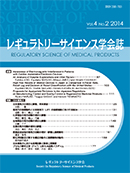Volume 11, Issue 2
Displaying 1-9 of 9 articles from this issue
- |<
- <
- 1
- >
- >|
-
2021Volume 11Issue 2 Pages 91
Published: 2021
Released on J-STAGE: May 31, 2021
Download PDF (125K)
-
2021Volume 11Issue 2 Pages 93-110
Published: 2021
Released on J-STAGE: May 31, 2021
Download PDF (455K)
-
2021Volume 11Issue 2 Pages 111-123
Published: 2021
Released on J-STAGE: May 31, 2021
Download PDF (430K)
-
2021Volume 11Issue 2 Pages 125-129
Published: 2021
Released on J-STAGE: May 31, 2021
Download PDF (260K) -
2021Volume 11Issue 2 Pages 131-138
Published: 2021
Released on J-STAGE: May 31, 2021
Download PDF (683K) -
2021Volume 11Issue 2 Pages 139-144
Published: 2021
Released on J-STAGE: May 31, 2021
Download PDF (1139K) -
2021Volume 11Issue 2 Pages 145-152
Published: 2021
Released on J-STAGE: May 31, 2021
Download PDF (355K) -
2021Volume 11Issue 2 Pages 153-159
Published: 2021
Released on J-STAGE: May 31, 2021
Download PDF (1497K)
-
2021Volume 11Issue 2 Pages 161-169
Published: 2021
Released on J-STAGE: May 31, 2021
Download PDF (513K)
- |<
- <
- 1
- >
- >|
